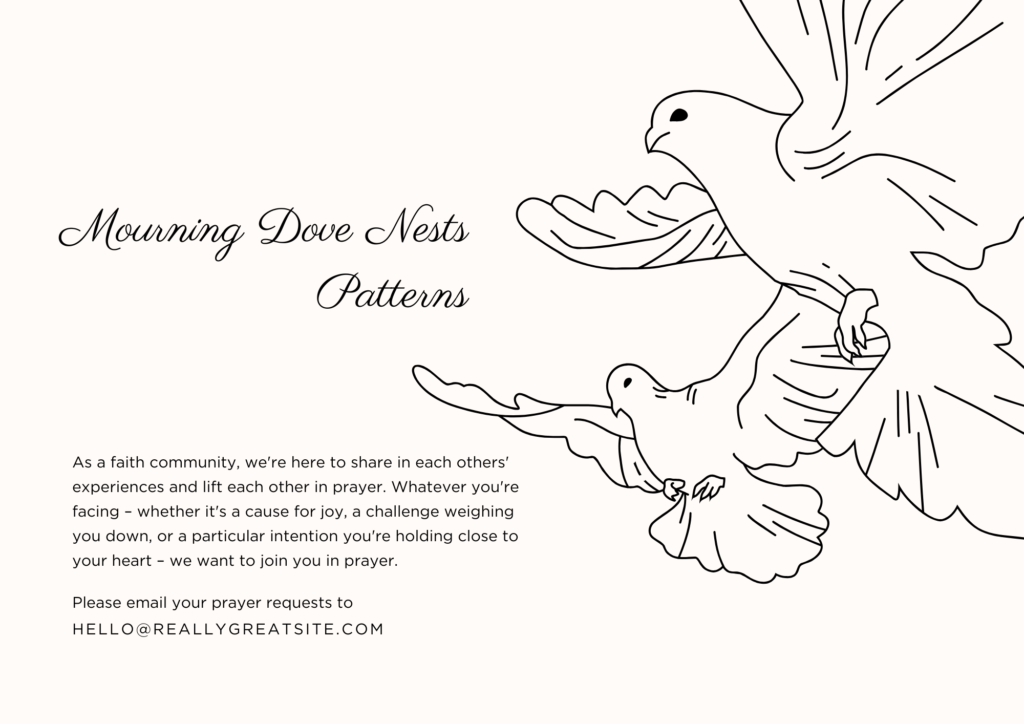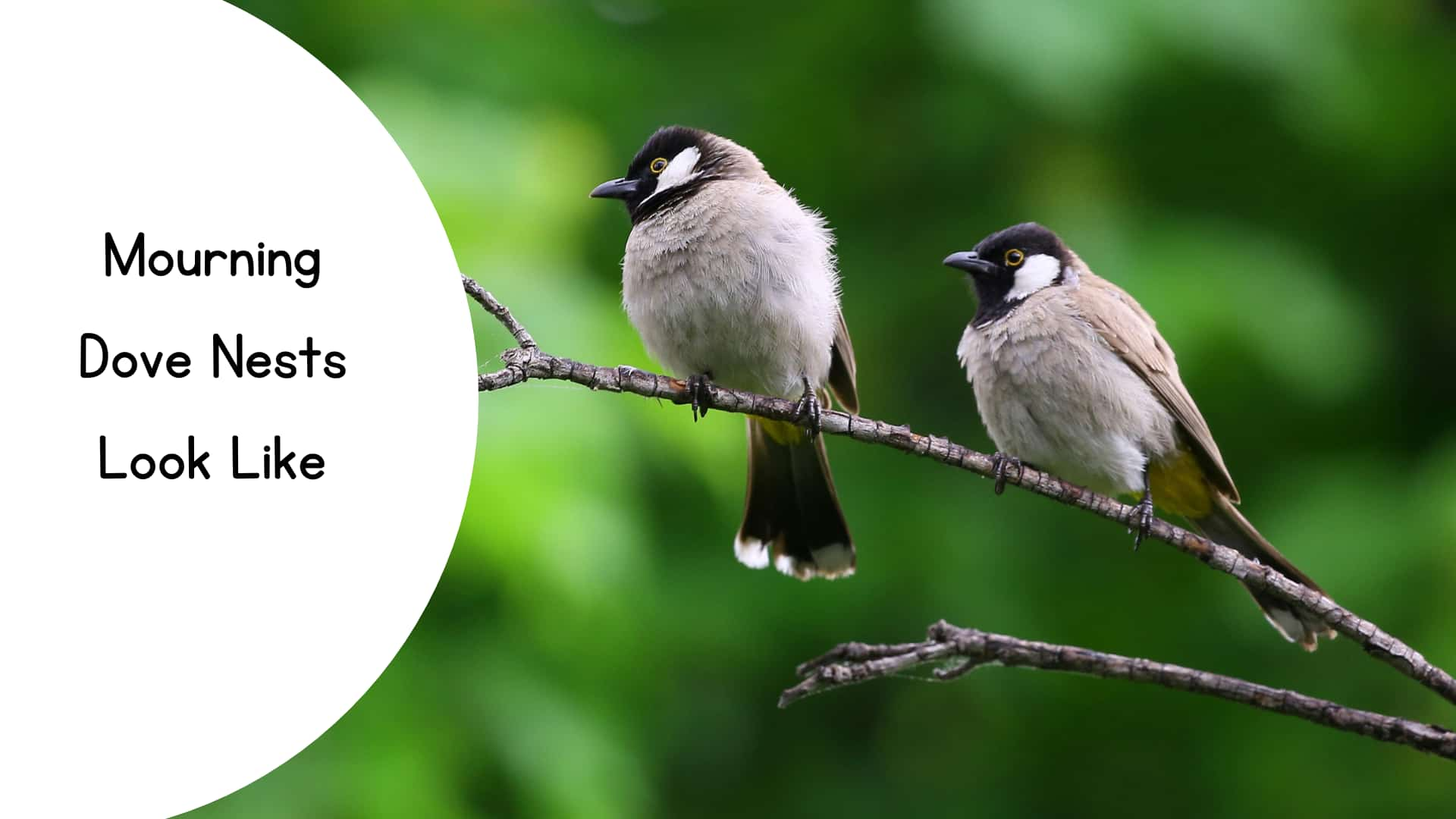Mourning Dove Nests Patterns
Specifically the Mourning Dove Nests, exhibit unique nesting behaviors that are crucial for their reproduction. These birds choose nesting sites that are relatively open yet offer some cover to protect against predators.
Commonly, they build their nests in trees, shrubs, or even on building ledges.
The construction of the nest is primarily the responsibility of the female dove, who weaves it together from twigs and other plant materials. Meanwhile, the male dove gathers and delivers the construction materials to the female. The nest typically appears quite loose and simple.
Mourning doves usually lay two eggs, and both parents play a role in the incubation process, which lasts about two weeks. After the eggs hatch, both parents also contribute to feeding the chicks, known as squabs, until they are ready to leave the nest.

Understanding the behavioral patterns of mourning doves can provide deeper insights into their survival strategies and the ecological challenges they face.
Detailed Exploration of Mourning Dove Nests and Reproductive Habits
Mourning doves, recognized for their gentle cooing and swift flight, engage in fascinating nesting behaviors that are both unique and strategically vital for their survival. This detailed exploration covers the intricacies of their nesting habits, choice of nesting sites, and the reproductive cycle, providing a comprehensive understanding of these serene birds.
Read more: Detailed Exploration of Mourning Dove Nests and Reproductive Habits
Construction of Mourning Dove Nests
Mourning Dove Nests typically start the nest-building process by selecting suitable materials such as pine needles, twigs, and grass, which are gathered primarily by the male. The chosen materials are often lightweight and pliable, leading to the construction of what many observers note as a somewhat flimsy nest structure.
The building phase can be remarkably swift, with some doves completing their nests in a single morning, although it can sometimes extend over several days. Interestingly, the male mourning dove occasionally interrupts the building process to court the female, which can sporadically delay the progress.
Selection of Nesting Sites
When it comes to selecting a nesting site, Mourning Dove Nests show a preference for locations that offer a blend of visibility and protection. A common choice is the horizontal fork of a tree branch, which provides a stable base for the precarious nest.
Additionally, these birds are also known to nest on the protected ledges of buildings, which offer shelter from predators and harsh weather conditions. It is important to note that mourning doves do not use artificially provided nest boxes, preferring natural or semi-natural environments for nesting.
Reproductive Cycle and Egg Incubation
Once the nest is prepared, the female dove lays her eggs, typically producing two eggs per breeding attempt. The first egg is laid soon after the completion of the nest, followed by the second within a day or two. Both parents participate actively in the incubation process, which lasts about 14 days.
Also read: Best Recipe for Hummingbird Food Ratio 3 to 1This shared responsibility ensures that the eggs are consistently kept at the necessary temperature for optimal development.
Hatching and Fledging
After the incubation period, the eggs hatch, revealing the dove chicks, or squabs. These young doves are initially completely dependent on their parents for nourishment.
Mourning dove parents are diligent in their care, feeding the squabs a nutrient-rich substance known as ‘crop milk,’ which is secreted from the lining of their crops. This phase of intense parental care ensures that the squabs develop rapidly, preparing to fledge the nest within two weeks of hatching.
Survival Strategies and Ecological Impact
The Mourning Dove Nests and reproductive behaviors of mourning doves play crucial roles in their survival and ecological adaptation. Their ability to quickly construct a nest, the strategic selection of nesting sites, and the efficient parental care strategies contribute significantly to the survival rates of their offspring.

Moreover, by understanding these patterns, ornithologists and bird enthusiasts can better appreciate the ecological challenges mourning doves face and the adaptations they have evolved to meet these challenges.
In conclusion, mourning doves exhibit a range of specialized behaviors and strategies throughout their nesting and reproductive phases. These insights not only enhance our understanding of mourning dove ecology but also enrich our broader knowledge of avian reproductive strategies under varying environmental conditions.
Early Nesting Habits of Mourning Doves
Initiation of Nesting Season
Mourning Dove Nests are known for their early start to the nesting season, a topic raised by a Birdzfly reader from Manahawkin, New Jersey. These birds begin their nesting preparations months in advance, with the timing varying geographically.
Read more: Initiation of Nesting Season
In northern regions, mourning doves may start building nests as early as March, while in the southern states, the process can begin even earlier, in February or January. This early start is crucial for the species’ reproductive strategy.
Frequent Nesting Attempts
Mourning Dove Nests are particularly industrious when it comes to breeding, often attempting to nest multiple times within a single season. It is common for a pair of mourning doves to undertake up to five broods from March through October. Each brood typically consists of two eggs, enhancing their chances of raising multiple offspring throughout the year.
Reasons for Early and Repeated Nesting
The rationale behind these early and repeated nesting attempts lies in the fragile nature of their nests. Mourning dove nests are relatively flimsy, which can sometimes result in the eggs or young birds falling out.
This vulnerability prompts the doves to nest repeatedly, a natural instinct that helps ensure enough young survive to maintain the population. This cycle of continuous nesting plays a critical role in the propagation and sustainability of the mourning dove species.
Through understanding these behaviors, observers and enthusiasts can gain insights into the survival strategies of mourning doves and the ecological challenges they navigate during their breeding seasons.
This knowledge not only enriches our appreciation of these common yet remarkable birds but also highlights the adaptability and resilience of avian species in varying environmental conditions.
Conclusion:
Characteristics of Mourning Dove Nests
Mourning dove nests are notably distinct in their construction and appearance, often described as surprisingly simple and somewhat precarious. Typically assembled from a sparse collection of twigs, grass, and occasionally pine needles, these nests may not seem robust at first glance.
However, their design is finely tuned to the needs of mourning doves. Positioned strategically within tree forks or on sheltered building ledges, these nests offer a blend of accessibility and protection from predators and the elements.
Despite their fragile appearance, the structure of mourning dove nests is a testament to the birds’ adaptation to their environment, allowing for rapid construction and flexibility in the face of environmental challenges.
This minimalist approach to nesting underscores the mourning dove’s survival strategy, emphasizing efficiency and the maximization of reproductive opportunities throughout the breeding season.
Through these nests, mourning doves manage to thrive in diverse environments, maintaining their population and ensuring their continued presence in their natural habitats.
FAQ’s:
1. What do mourning dove nests look like?
Mourning dove nests are generally simple and flimsy, constructed from loosely arranged twigs, grass, and occasionally pine needles. They often appear quite minimalistic.
2. Where do mourning doves typically build their nests?
Mourning doves prefer to build their nests in the forks of trees, on building ledges, or other sheltered spots that provide some protection from the elements and predators.
3. When do mourning doves start nesting?
In the southern states, mourning doves may begin nesting as early as January or February, while in northern regions, they typically start around March.
4. How many broods do mourning doves raise each year?
Mourning doves can raise multiple broods, sometimes up to five, between March and October, depending on the region and conditions.
5. Why do mourning doves nest so early in the year?
Mourning doves nest early to maximize their breeding opportunities and to ensure that they can raise as many young as possible within a breeding season.
6. How many eggs do mourning doves lay per brood?
Mourning doves usually lay two eggs per brood.
7. What challenges do mourning dove nests face?
Due to their flimsy construction, mourning dove nests are vulnerable to being disturbed by strong winds, predators, and other environmental factors, which can cause the eggs or chicks to fall out.

